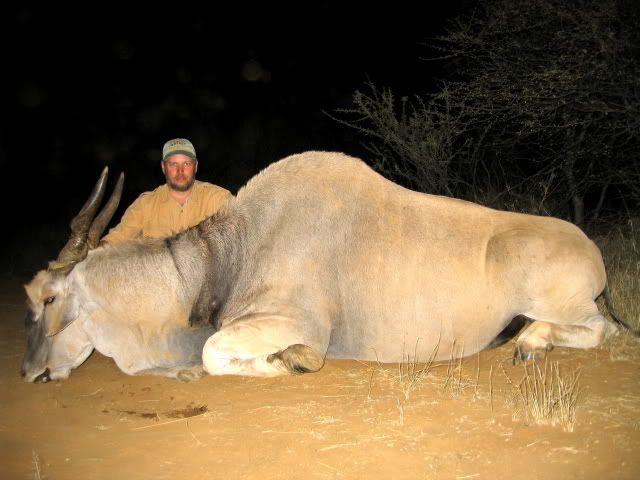

 The Accurate Reloading Forums
The Accurate Reloading Forums  THE ACCURATE RELOADING.COM FORUMS
THE ACCURATE RELOADING.COM FORUMS  Hunting
Hunting  African Big Game Hunting
African Big Game Hunting  Eland Question
Eland QuestionGo  | New  | Find  | Notify  | Tools  | Reply  |  |
| One of Us |
I noticed on one Namibia PH's website reference to Livingston Eland and Cape Eland. This is in NW Namibia. Can someone please explain the difference. | ||
|
| one of us |
It is just like the difference between the differnt kinds of deer here in the US. They look very much alike but are different species. The Namibian operator has stocked both types on his land. Mark MARK H. YOUNG MARK'S EXCLUSIVE ADVENTURES 7094 Oakleigh Dr. Las Vegas, NV 89110 Office 702-848-1693 Cell, Whats App, Signal 307-250-1156 PREFERRED E-mail markttc@msn.com Website: myexclusiveadventures.com Skype: markhyhunter Check us out on https://www.facebook.com/pages...ures/627027353990716 | |||
|
| One of Us |
They are not different species. It is questionable in mamology whether they are even seperate sub-species. You have two individuals from the same species living in seperate areas for long amounts of time. With natural genetic selection certian phenotypes are exibited that make them look slightly different. Most notibly hair length and color. However the genotype has not varied widely enough to classify them as seperate species. | |||
|
| one of us |
Hartmann's zebra and plains zebra just look alike but are different species. Greater Southern Kudu and lesser kudu also just look alike but are different species. Lord Derby eland, cape eland, and Livingston eland are all the same species but like "smarter" above says have local variations that set them apart from one another. They will all interbreed, and are as closely related as Rocky Mountain Elk and Roosevelt Elk. I doubt eland, even though from different stock, living and breeding in the same place for any length of time, would maintain their "subspecies" characteristics. | |||
|
| One of Us |
and they all taste the same - yum yum | |||
|
| One of Us |
Would the horns/antlers be comparative? | |||
|
| One of Us |
If a cape eland skull sat next to a Livingston's eland skull no man could tell the difference with certianty. | |||
|
| one of us |
Guys, Sorry! I'll have to be careful with my terminology. Having shot Cape, Livingstone's, East African and Lord Derby eland I must admit I saw little difference in the first 3 once on the ground but it was a great excuse to shoot another of those big boys. Mark MARK H. YOUNG MARK'S EXCLUSIVE ADVENTURES 7094 Oakleigh Dr. Las Vegas, NV 89110 Office 702-848-1693 Cell, Whats App, Signal 307-250-1156 PREFERRED E-mail markttc@msn.com Website: myexclusiveadventures.com Skype: markhyhunter Check us out on https://www.facebook.com/pages...ures/627027353990716 | |||
|
| One of Us |
They are different - albeit small differences. Enough to make cross-bred animals worth their meat value only as far as game rancing is concerned. The main differences are size, the white lines on the body and a more pronounced tuft on the face of the Livingstone "variety". I agree that it will be close to impossible to tell the difference looking at a skull only.  Livingstone Eland, Coutada 10, Mozambique Johan | |||
|
| One of Us |
Lord Derbys are generally found in western africa the C.A.R, Camaroun(sic) and have longer horns, a darker cape and are generally the heaviest, Livingstones, the one I shot was in Zimbabwe have horns shorter than the LD's but are the same size (1,500-2,000)lbs. Capes are generally the smallest in size at around 900lbs, lack the stripes of a LD or Livs. Notice how many times I said "generally". As was said above, they can come in alot of sizes and colors. The one below is a Livingtone Hugh   Pro Staff for: In Natures Image Taxidermy | |||
|
| One of Us |
Is that a little "battle scar" above the left eye, perhaps? Johan | |||
|
| one of us |
I'm not sure if this means anything, but I was talking to Dirk de Bod in Reno last month and discovered that Vaughan Fulton and I had been hunting eland on a cattle ranch outside Otavi, Namibia near where I believe he said he grew up. He showed me a picture of an eland that was killed very close to where I took mine and it had very distinctive white stripes on its back. This was not a game ranch eland but part of the indigenous eland of the area. I mentioned the stripes and he said this area is where the Cape and Livingstone (I believe) ranges meet, thus the stripes. After looking at a picture of my eland he pointed out very faint stripes on mine as well, which I had not noticed until this point.  "...Africa. I love it, and there is no reason for me to explore why. She affects some people that way, and those who feel as I do need no explanation." from The Last Safari | |||
|
| One of Us |
Thanks, that's the infoI needed. | |||
|
| Powered by Social Strata |
| Please Wait. Your request is being processed... |
|

Visit our on-line store for AR Memorabilia

